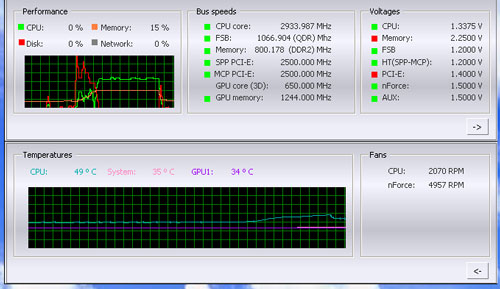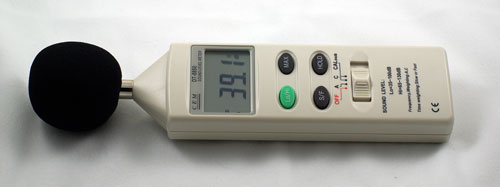The Zalman Twins: 9500 & 9700 Air Tunnels
by Wesley Fink on February 19, 2007 12:40 AM EST- Posted in
- Cases/Cooling/PSUs
CPU Cooling Test Configuration
The standard test bed for cooling tests uses an EVGA NVIDIA 680i SLI motherboard. This is primarily based on the consistent test results on this board and the excellent NVIDIA Monitor temperature measurement utility, which is part of the nTune program.
NVIDIA Monitor has a drop-down pane for temperature measurement which reports CPU, System, and GPU results. Reviews at this point will concentrate primarily on CPU temperature. In addition to the real-time temperature measurement, NVIDIA Monitor also has a logging feature which can record temperature to a file in standard increments (we selected every 4 seconds). This allows recording of temperatures during testing and play back, for example, of stress test results that can then be examined when the stress tests are completed. There is also the handy reference of speeds and voltages in the top pane to confirm the test setup.
Other components in the cooling test bed are generally the same as those used in our motherboard and memory test bed:
| Cooling Performance Test Configuration | |
| Processor | Intel Core 2 Duo X6800 (x2, 2.93GHz, 4MB Unified Cache) |
| RAM | 2x1GB Corsair Dominator PC2-8888 (DDR2-1111) |
| Hard Drive(s) | Hitachi 250GB SATA2 enabled (16MB Buffer) |
| Video Card: | 1 x EVGA 7900GTX - All Standard Tests |
| Platform Drivers: | NVIDIA 9.53 |
| NVIDIA nTune: | 5.05.22.00 (1/16/2007) |
| Video Drivers: | NVIDIA 93.71 |
| CPU Cooling: | Zalman CNPS9700 Zalman CNPS9500 Cooler Master Hyper 6+ Vigor Monsoon II Lite Thermalright MST-9775 Scythe Katana Tuniq Tower 120 Intel Stock HSF for X6800 |
| Power Supply: | OCZ PowerStream 520W |
| Motherboards: | EVGA nForce 680i SLI (NVIDIA 680i) |
| Operating System(s): | Windows XP Professional SP2 |
| BIOS | Award P24 (1/12/2007) |
All cooling tests are run with the components mounted in a standard mid-tower case. The idle and stress temperature tests are run with the case closed and standing as it would in most home setups. We do not use auxiliary fans in the test cooling case, except for the north bridge fan attached to the 680i for overclocking.
We first tested the stock Intel cooler at standard X6800 speed, measuring the CPU temperature at idle and while the CPU was being stressed. We stressed the CPU by running continuous loops of the Far Cry River demo. The same tests were repeated at the highest stable overclock we could achieve with the stock cooler. Stable in this case meant the ability to handle our Far Cry looping for at least 30 minutes.
The same tests were then run on the cooler under test at stock, highest stock cooler OC speed (3.73GHz), and the highest OC that could be achieved in the same setup with the cooler being tested. This allows measurement of the cooling efficiency of the test unit compared to stock and the improvement in overclocking capabilities, if any, from using the test cooler.
Noise Levels

In addition to cooling efficiency and overclocking abilities, users shopping for CPU cooling solutions may also be interested in the noise levels of the cooling devices they are considering. Noise levels are measured with the case open on its side and are measured using a C.E.M. DT-8850 Sound Level meter. This meter allows accurate sound level measurements from 35bdB to 130dB with a resolution of 0.1dB and an accuracy of 1.5dB. This is sufficient for our needs in these tests, as measurement starts at the level of a relatively quiet room. Our own test room, with all computers and fans turned off, has a room noise level of 36.4dB.
Our procedures for measuring cooling system noise are described on page seven along with noise results comparing the stock Intel cooler and recently tested CPU coolers to the Zalman CNPS9500 and CNPS9700 coolers.










50 Comments
View All Comments
Avalon - Monday, February 19, 2007 - link
Keep up the good work. I'm enjoying watching the list of coolers you guys review grow and grow, and I think it's great that you'll be doing the Scythe Infinity and Ninja soon. I know I've mentioned this before, but I still want to see the Coolermaster Hyper TX if you guys can get your hands on one. Reason being is it looks as though it provides excellent PWM area cooling...which brings me to my next question...Have you guys considered throwing in PWM area temperatures? Some coolers are great at cooling the CPU, but awful at providing air anywhere else...and PWM cooling can help with stability.
Wesley Fink - Monday, February 19, 2007 - link
We agree that PWM is an important consideration, and it is something we will likely visit in a future article. Most of the top motherboards these days use passive sinks on the power transisitors and northbridges, but they also come with cooling fans for use with water cooling and HSFs that do not provide good cooling for board components. The 680i has such a fan and we use it in our testing to try to remove the variable PWM air flow and temps as a performance factor. Of course, that avoids the question by removing the variable, rather than answering it. We will try to address this in some future article, but for now we have a lot more coolers waiting for tests on our standard test bed.acivick - Monday, February 19, 2007 - link
I didn't see it listed anywhere in the review, but I'm assuming that the included thermal compound was used, at least for the 9500/9700. If the same compound was not used for all coolers, they should be retested, as it's not a valid test. Using the same compound on each would make it more of an even playing field and would thus be testing the performance of the cooler only.For instance, MX-1 is supposed to be much better than the stuff Zalman provided, giving a 3-5C decrease in overall temperatures.
Wesley Fink - Monday, February 19, 2007 - link
We use the thermal compound that comes with the cooler in most cases. If it is just a little packet of cheap thermal compound we use our standard, which is a silver colored tube thermal compound of pretty decent performance - not something exotic like MX-1.In the case of the Zalman 9500 and 9700 we used the Zalman Thermal Grease. Before replying to this question I tested the Tuniq Tower 120 with the Zalman Thermal Grease. Results were all but identical to the tests we ran using our bulk silver colored compound.
Over the years I've used many thermal compounds, and if you use a quality product and apply it properly the results have been similar. I hear what you are saying about a 3-5C difference with MX-1, but I certainly have not seen those kinds of gains with any thermal grease. I can also point you to a serious review that shows toothpaste and Vegemite with superior performance to Arctic Silver 5. At some point in the future we might take a closer look at the impact of thermal compounds on performance, but for now I am confident our current test methods are not introducing new variables with sloppy choices of thermal compound. We are prudent in our choices, but not maniacal.
JarredWalton - Monday, February 19, 2007 - link
Except a lot of people use whatever comes with the HSF. Wes would have to explain what thermal compound he's using, but I would assume he's sticking with the included stuff for each HSF where possible. If nothing is included... well, I don't know what he does there. :) Basically, though, I don't think retesting is in order unless he's using high-grade stuff on HSFs that omit the inclusion of a compound.VooDooAddict - Monday, February 19, 2007 - link
I agree that he should make it clear though what he's using.Using the shipped compound with these units would be preferable from complete product a review standpoint. As it stands there's no mention of his cleaning and reapplying new compound either. From a simplicity standpoint of reviewing and a better comparison of coolers, it would be easier to just use one compound for all the coolers to reduce cleaning time and variables.
ozzimark - Monday, February 19, 2007 - link
umm, my 9500 looks NOTHING like that base :-Xhttp://www.eclipseoc.com/image/cooling/zalman%20cn...">click for pic!
dev0lution - Monday, February 19, 2007 - link
Good info. I was leaning towards getting the 9500 since I don't think my 7700-alCu will fit on the eVga 680i board I haven't got around to installing. I might consider getting one of the alternatives now, seeing as how it doesn't look like the zalman's are worth the price premium.Fishie - Monday, February 19, 2007 - link
The Tuniq is 54dBs while the 9700 is 57dBs. Twice as loud? Wouldn't twice as loud be 108dBs? Not to mention the 9700 is quieter than the Tuniq at 24" away.
Wesley Fink - Monday, February 19, 2007 - link
3db is twice the sound energy, since the db scale is logarithmic. At one time twice the energy was considered twice as loud, but recent research shows 6db to 10db increase to be perceived by the human ear as twice as loud - depending on whose study you read. I have stated this in past reviews. To be more precise I changed the wording in the review to twice the sound energy.